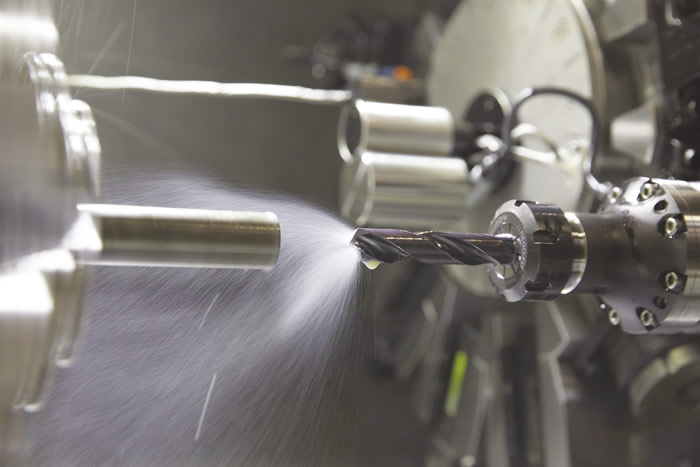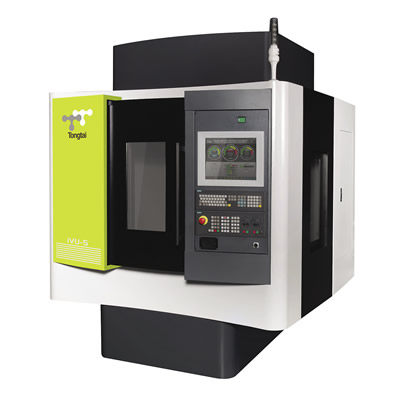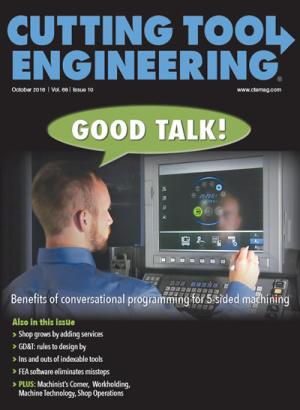With an assist from sound that humans can’t hear, machining can be a cooler and faster process—and yield more accurate results to boot.
So say fans of ultrasonic-assisted (UA) machining, the application of intense acoustic waves to conventional metalcutting operations. While the frequencies of these waves can vary, 20kHz is commonly used to stay above the audible range of most adults, according to Matt Short, technology leader for ultrasonics for EWI, Columbus, Ohio, which develops technologies aimed at helping companies bridge the gap between R&D and commercial implementation.


Acoustech Systems’ NRT module drills stainless steel. Image courtesy EWI.

Acoustic waves create an oscillatory motion along the tool axis, which Short described as an expansion and contraction that displaces the tool tip about 30µm (0.0012"). Like conventional ultrasonic machining, UA machining relies on an ultrasonic transducer to create acoustic waves. But unlike ultrasonic machining, which uses the oscillatory motion of a tool to essentially peck away material, UA machining techniques attempt to keep the oscillating tools—in this case, conventional cutting tools such as drills—engaged with the material during the cutting process, Short explained.
Ultrasonic energy introduced into machining processes changes the physics of these processes in a way that significantly reduces the cutting force, said Short. The lower cutting force reduces the amount of heat and plastic deformation produced during machining, making a tool more effective as it shears material.
“Every year, companies spend millions of dollars on ways to extract heat from the process,” Short said. “But … it is possible to leverage [UA machining] to not create heat in the first place.” He added that advantages related to reduced cutting force and heat include longer tool life, finer surface finishes, increased feed rates, tighter tolerances and fewer burrs.
Short believes UA machining is particularly well-suited for aerospace and nuclear applications, which often involve materials such as titanium, stainless steel and nickel-base superalloys. Why? The heat created by conventional machining produces a grain structure that makes these challenging materials even more difficult to cut, he explained.
For UA machining to work, however, the cutting tool must be resonant within the bandwidth of the transducer and power supply. So tool length and geometry, which impact operating frequency, must be considered when planning a UA machining process, Short noted.


The new iVU-5 from Tongtai can operate with or without ultrasonic-assist. Image courtesy Absolute Machine Tools.

A significant development in UA machining technology, according to Short, is EWI’s “ultrasonic machining module.” Designed in the form of a conventional toolholder, the module can be attached to new and old machines. EWI’s module technology is the basis for the NFP and NRT units from Acoustech Systems, also of Columbus, for multiple-spindle machines and lathes that perform centerline work.
Another option for UA machining is the iVU-5 from Taiwan-based Tongtai Machine & Tool Co. Ltd. The dual-function iVU-5 can operate as a vertical machining center and perform rotary UA machining.
Rotary UA machining combines high-speed spindle rotation with high-frequency vertical vibration of the cutting tool to reduce the cutting force, boost productivity (in its UA mode, the iVU-5 cuts three to five times faster than conventional machine tools) and impart ultrafine finishes, according to Absolute Machine Tools Inc., Lorain, Ohio, which sells the machine in the U.S.
Applications for the iVU-5 include microdrilling and machining of hardened steel, aluminum and high-nickel alloys. Before the introduction of the iVU-5, “manufacturers would have to use a slower EDM approach for microhole production,” said Courtney Ortner, Absolute’s chief marketing officer.
On the downside, the iVU-5 costs more than a wire EDM. Then again, Ortner noted, buyers “are getting two machines in one.”
Related Glossary Terms
- alloys
alloys
Substances having metallic properties and being composed of two or more chemical elements of which at least one is a metal.
- cutting force
cutting force
Engagement of a tool’s cutting edge with a workpiece generates a cutting force. Such a cutting force combines tangential, feed and radial forces, which can be measured by a dynamometer. Of the three cutting force components, tangential force is the greatest. Tangential force generates torque and accounts for more than 95 percent of the machining power. See dynamometer.
- electrical-discharge machining ( EDM)
electrical-discharge machining ( EDM)
Process that vaporizes conductive materials by controlled application of pulsed electrical current that flows between a workpiece and electrode (tool) in a dielectric fluid. Permits machining shapes to tight accuracies without the internal stresses conventional machining often generates. Useful in diemaking.
- feed
feed
Rate of change of position of the tool as a whole, relative to the workpiece while cutting.
- machining center
machining center
CNC machine tool capable of drilling, reaming, tapping, milling and boring. Normally comes with an automatic toolchanger. See automatic toolchanger.
- metalcutting ( material cutting)
metalcutting ( material cutting)
Any machining process used to part metal or other material or give a workpiece a new configuration. Conventionally applies to machining operations in which a cutting tool mechanically removes material in the form of chips; applies to any process in which metal or material is removed to create new shapes. See metalforming.
- plastic deformation
plastic deformation
Permanent (inelastic) distortion of metals under applied stresses that strain the material beyond its elastic limit.
- superalloys
superalloys
Tough, difficult-to-machine alloys; includes Hastelloy, Inconel and Monel. Many are nickel-base metals.
- toolholder
toolholder
Secures a cutting tool during a machining operation. Basic types include block, cartridge, chuck, collet, fixed, modular, quick-change and rotating.
- ultrasonic machining
ultrasonic machining
Material-removal operation in which an abrasive slurry flows between a tool, vibrating at a high frequency, and a workpiece.
- wire EDM
wire EDM
Process similar to ram electrical-discharge machining except a small-diameter copper or brass wire is used as a traveling electrode. Usually used in conjunction with a CNC and only works when a part is to be cut completely through. A common analogy is wire electrical-discharge machining is like an ultraprecise, electrical, contour-sawing operation.


